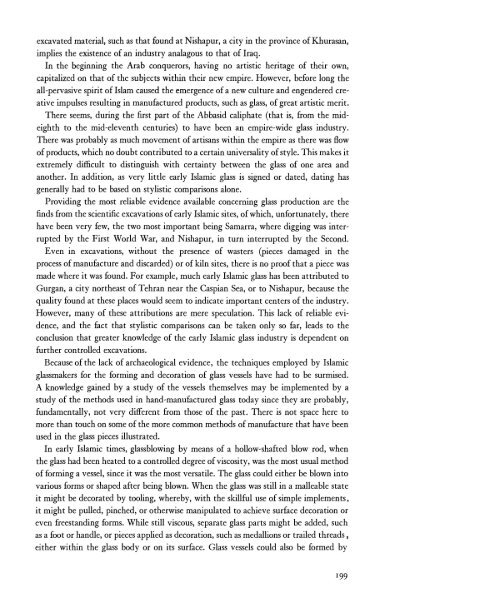Islamic Art: The Metropolitan Museum of Art Bulletin, v. 23, no. 6 ...
Islamic Art: The Metropolitan Museum of Art Bulletin, v. 23, no. 6 ...
Islamic Art: The Metropolitan Museum of Art Bulletin, v. 23, no. 6 ...
Create successful ePaper yourself
Turn your PDF publications into a flip-book with our unique Google optimized e-Paper software.
excavated material, such as that found at Nishapur, a city in the province <strong>of</strong> Khurasan,<br />
implies the existence <strong>of</strong> an industry analagous to that <strong>of</strong> Iraq.<br />
In the beginning the Arab conquerors, having <strong>no</strong> artistic heritage <strong>of</strong> their own,<br />
capitalized on that <strong>of</strong> the subjects within their new empire. However, before long the<br />
all-pervasive spirit <strong>of</strong> Islam caused the emergence <strong>of</strong> a new culture and engendered creative<br />
impulses resulting in manufactured products, such as glass, <strong>of</strong> great artistic merit.<br />
<strong>The</strong>re seems, during the first part <strong>of</strong> the Abbasid caliphate (that is, from the mid-<br />
eighth to the mid-eleventh centuries) to have been an empire-wide glass industry.<br />
<strong>The</strong>re was probably as much movement <strong>of</strong> artisans within the empire as there was flow<br />
<strong>of</strong> products, which <strong>no</strong> doubt contributed to a certain universality <strong>of</strong> style. This makes it<br />
extremely difficult to distinguish with certainty between the glass <strong>of</strong> one area and<br />
a<strong>no</strong>ther. In addition, as very little early <strong>Islamic</strong> glass is signed or dated, dating has<br />
generally had to be based on stylistic comparisons alone.<br />
Providing the most reliable evidence available concerning glass production are the<br />
finds from the scientific excavations <strong>of</strong> early <strong>Islamic</strong> sites, <strong>of</strong> which, unfortunately, there<br />
have been very few, the two most important being Samarra, where digging was interrupted<br />
by the First World War, and Nishapur, in turn interrupted by the Second.<br />
Even in excavations, without the presence <strong>of</strong> wasters (pieces damaged in the<br />
process <strong>of</strong> manufacture and discarded) or <strong>of</strong> kiln sites, there is <strong>no</strong> pro<strong>of</strong> that a piece was<br />
made where it was found. For example, much early <strong>Islamic</strong> glass has been attributed to<br />
Gurgan, a city <strong>no</strong>rtheast <strong>of</strong> Tehran near the Caspian Sea, or to Nishapur, because the<br />
quality found at these places would seem to indicate important centers <strong>of</strong> the industry.<br />
However, many <strong>of</strong> these attributions are mere speculation. This lack <strong>of</strong> reliable evidence,<br />
and the fact that stylistic comparisons can be taken only so far, leads to the<br />
conclusion that greater k<strong>no</strong>wledge <strong>of</strong> the early <strong>Islamic</strong> glass industry is dependent on<br />
further controlled excavations.<br />
Because <strong>of</strong> the lack <strong>of</strong> archaeological evidence, the techniques employed by <strong>Islamic</strong><br />
glassmakers for the forming and decoration <strong>of</strong> glass vessels have had to be surmised.<br />
A k<strong>no</strong>wledge gained by a study <strong>of</strong> the vessels themselves may be implemented by a<br />
study <strong>of</strong> the methods used in hand-manufactured glass today since they are probably,<br />
fundamentally, <strong>no</strong>t very different from those <strong>of</strong> the past. <strong>The</strong>re is <strong>no</strong>t space here to<br />
more than touch on some <strong>of</strong> the more common methods <strong>of</strong> manufacture that have been<br />
used in the glass pieces illustrated.<br />
In early <strong>Islamic</strong> times, glassblowing by means <strong>of</strong> a hollow-shafted blow rod, when<br />
the glass had been heated to a controlled degree <strong>of</strong> viscosity, was the most usual method<br />
<strong>of</strong> forming a vessel, since it was the most versatile. <strong>The</strong> glass could either be blown into<br />
various forms or shaped after being blown. When the glass was still in a malleable state<br />
it might be decorated by tooling, whereby, with the skillful use <strong>of</strong> simple implements,<br />
it might be pulled, pinched, or otherwise manipulated to achieve surface decoration or<br />
even freestanding forms. While still viscous, separate glass parts might be added, such<br />
as a foot or handle, or pieces applied as decoration, such as medallions or trailed threads,<br />
either within the glass body or on its surface. Glass vessels could also be formed by<br />
I99

















